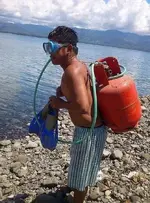Furthermore...
If you read tank manuals...
A. NORMAL SERVICE. The visual inspection of every scuba cylinder should take place at least once every twelve months, or at any opportune time under twelve months15. Some scuba cylinders need more frequent visual inspection, as indicated below. B. HEAVY SERVICE. If the cylinder is used in heavy service then it should be inspected every four months. “Heavy service” means any one or more of the following: 1. Cylinders being filled or “topped off” five or more times per week; 2. Rental cylinders in use during the ‘season’ and ‘off-season’ times; 3. Cylinders used wherever damage is more likely than in normal use or where the care and/or maintenance is slightly below recommended care.4 C. KNOWN CONDITION. If the cylinder is known to have had any unusual treatment or condition, it should be immediately visually inspected, prior to its next use. “Unusual treatment or condition” means if the cylinder: 1. Dropped, fell, was struck, was in an accident, or when the care and maintenance of the cylinder is obviously poor; 2. Was stored improperly4 and shows signs of damage; 3. Has obvious corrosion since the last visual inspection; 4. Has a gouge, dent, scrape, cut, dig or, in any way, has been damaged since the last visual inspection; 5. Was stored with water, material or matter inside the cylinder; 6. Shows signs of exposure to fire or high heat, including any one or more of the following: a. Charring or blistering of the paint or other protective coating; b. Melting or charring of the metal; c. Distortion of the cylinder and/or any cylinder accessory; d. Melting of fuse plugs, valve handwheel, valve protector, and/or any other valve component or cylinder accessory; 7. Has been partially or fully repainted or treated to hide damage and/or fire damage; 8. Is known or suspected to be leaking; or, 9. Is known or suspected of having a crack. Inspectors should be familiar with all conditions that could CONDEMN a Gas Cylinders scuba cylinder from further use. WARNING: Should an incident occur that could damage a cylinder, the cylinder should be immediately taken out of service, inspected and if needed, condemned.
NEVER: • use a cylinder past its retest date.
Storage - Short term: Tightly close the cylinder valve. Leave some pressure in the cylinder. Secure cylinder and assembly from rolling loose, tipping over or falling. Store at room temperature in a dry place. Long term: Prior to prolonged storage, the valve should be removed from the empty cylinder. Wash the cylinder internally and externally with fresh tap water, then thoroughly dry (inside and out). Install the valve using a small amount of Dow 111 Lubricant on the threads following the valve manufacturer’s recommended valve installation procedures. Replace the O-ring if the manufacturer recommends it. Store valved cylinder at room temperature in dry conditions either upright or horizontal, but never inverted, with some positive pressure in the cylinder (not less than 20 psig). Never store a cylinder near heat or in a place likely to get artificially hot.




